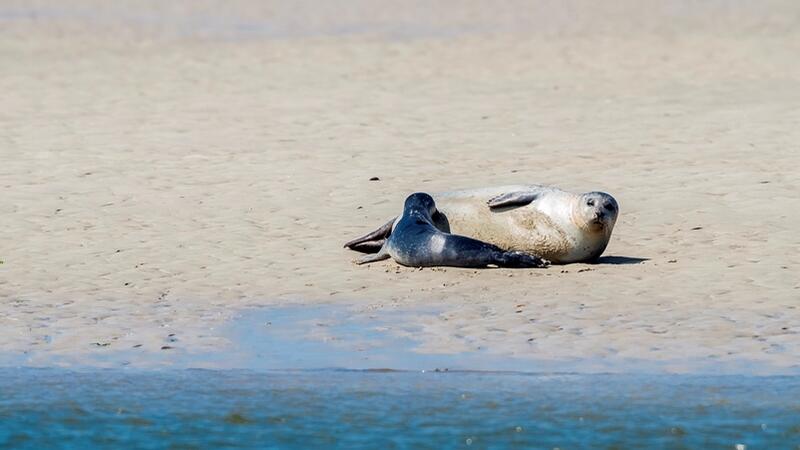Seal counts 2017: Harbour seal pup count reaches all-time high; overall population stagnates

During the 2017 aerial surveys for harbour seal counts, the number of newborn harbour seal pups in the Wadden Sea registered was the highest since the first surveys in 1975. In the same year, the overall population decreased slightly in comparison to previous years. The surveys are coordinated annually by the Trilateral Sea Expert Group (TSEG) and cover the Wadden Sea from Denmark via Germany to the Netherlands.
“There is a contradiction of pup and adult seal numbers”, explains Sascha Klöpper, Deputy Executive Secretary of the Common Wadden Sea Secretariat (CWSS) and responsible for Ecosystem Management. “An explanation may be that the carrying capacity is reached and might therefore cause adult seals to swim longer distances to feed. The seals would still return to the breeding area for pupping. However, the TSEG cannot exclude a rising pup mortality in the area. In order to confirm either of the scenarios, we will continue to closely monitor the harbour seals of the Wadden Sea.” In June 2017, 9,167 newborn pups were counted in the Wadden Sea – 24% more than in 2016. This is the highest recorded number of pups since 1974. In all parts of the Wadden Sea, the experts counted a double-digit increase – with the largest increase, amounting to +28% recorded in Schleswig-Holstein.
This trend is not replicated in the numbers of adult seals: Traditionally the seal counts are conducted during the moulting period in August, when many animals rest on haul out sites on sand banks and beaches. During the moult in August 2017, Denmark recorded 2,971 harbour seals, Schleswig-Holstein counted 8,834, and 7,311 were seen in Lower Saxony. In the Netherlands 5,920 were counted, however, an area holding approximately 800-1000 seals could not be surveyed at that time due to military activities. To correct the numbers, 900 animals were added to this total as indicative. The development of the harbour seal population varies between the regions: While there was a substantial increase in Denmark (38%) and Schleswig-Holstein (34%) in comparison to the previous year, the indicated population in Lower Saxony and Hamburg dropped by 16% and a slight decrease of 4% was detected in the Netherlands. The regional results reverse the numbers of the surveys from the previous years, when a decrease was detected in the Northern Wadden Sea, while population increased in the Southwest.
“The new figures show that harbour seals are faring well in the Wadden Sea, which is good news. However, the current uncertainty as to which of the two theories that could possibly explain the seeming contradiction between an increase in pup numbers and stability of the population as a whole once again underscores the importance of the trilateral surveys”, says Klöpper.
Harbour seals are one of the most iconic of 10,000 species that can be found in the Wadden Sea and one of the many reasons why the site was listed as World Heritage in 2009. Aerial counts of harbour seals have been conducted annually in the Danish, Dutch and German Wadden Sea area since 1975. The Trilateral Seal Expert Group (TSEG) is part of the Trilateral Wadden Sea Cooperation. The TSEG coordinates the counts and harmonizes the data from across the Wadden Sea region. Harbour seals in the Wadden Sea are specially protected and continually monitored under the Agreement on the Conservation of Seals in the Wadden Sea (WSSA) concluded under the auspices of the UN Convention on the Conservation of Migratory Species of Wild Animals (CMS). WSSA was the first daughter agreement concluded under CMS. CWSS acts as the secretariat of WSSA.
